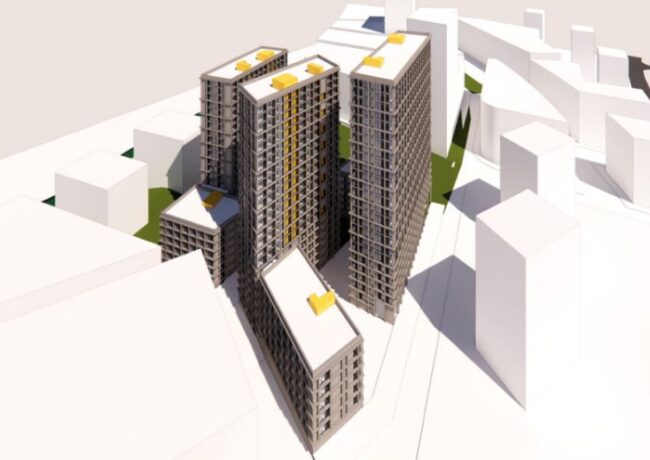SPECIAL REPORT | Buildings ‘must respond to climate crisis’
Extinction Rebellion’s Jasmin Eastwood has stewarded at protests and camped out for a week as part of last summer’s pedestrianised blockade in Manchester, and she also happens to be an architect at Sheppard Robson.
Sitting down with Place North West, Eastwood spoke about combining membership of XR with being a property professional.
“Ultimately, it’s economically viable for the sector to push to make buildings net zero,” she explains. “Instead of looking at short-term profit, companies should be looking at long-term gain.”
While the term ‘net zero’ has become increasingly common, Eastwood clarified the difference between perceived net zero and actual net zero.
“The definition of net zero has been diluted to mean ‘operations only’, which means that only the carbon produced during the use of the building is accounted for and counteracted. This doesn’t offset the carbon cost of developing the building itself, which is known as embodied carbon.
“It is estimated that up to 28% of energy used in a building’s lifetime comes from embodied carbon in terms of the materials process and transportation used in construction.”
When asked if any developers or companies were ahead on this, Eastwood was quick to highlight a few.
“Peel has a net zero agenda. Its work is highly commendable, and it is clearly an industry leader in the North West, but achieving net zero is not simply offsetting the carbon you create. Peel plants trees and fits solar panels amongst other acts but doesn’t always retrofit its properties.
“That’s where it should lean in the long run; a fabric first approach, maximising the efficiency of the building’s envelope and components, prior to adding more M&E offsetting. This offers the best means for reducing a building’s carbon footprint in the long run.”
She continues: “Family-owned developers are also leading the charge, including companies such as Bruntwood who have plans to take their Bright Building at Manchester Science Park completely off-grid. These are the developers whose business model is planned around the long-term for future generations of the business.
“Universities are similar. They are already requesting net zero buildings going forward for the same reasons as family developers; they are interested in longevity.”
At its core, the property sector contributes £101bn to the UK each year, which makes up 7% of the UK GVA. Carbon neutralising a building is predicted to cost between 5% to 15% on top of the construction costs to meet XR accredited design standards, so how can we incentivise the sector to respond to climate change?
In the built environment, where construction is estimated to be responsible for 39% of all carbon emissions in the world according to the World Green Building Council, does a more forceful hand need to be taken, such as introducing changes at policy level, or does it require more radical actions?
Extinction Rebellion is known across the country for causing disruption to raise awareness of climate change. In Manchester, XR has closed down Deansgate and Great Ancoats Street in temporary protests, challenging the city’s dependence on cars.
Although it is in the best interests of the built environment to change its ways, Eastwood acknowledges that carbon neutralising the industry is “a massively complicated beast.”
Eastwood explains: “By 2050, the year by which the UK aims to be zero carbon, 85% of homes that have been built between now and then will still be standing, so there is a massive challenge to upgrade them, and all of the other buildings, to make them zero carbon.
“The massive challenge there of course is that new builds attract 0% VAT, while refurbished buildings attract 20%. This means that from day one, the cost differential can make demolition and rebuilding more appealing than retrofitting an existing building.
“Buildings need to respond to the climate crisis. We can’t continue to build the way we’ve previously been going about it.”
Climate change has risen up society’s agenda in part due to XR’s emergence and the media’s coverage of Greta Thunberg in the past two years. The importance of the climate crisis has become a daily, pressing issue. As climate awareness has grown, have the design principles needed to create an ‘ideal standard’ kept pace to help the property industry achieve net-zero buildings?
“The Passivhaus Standard is one of the main proven design approaches to achieving a net zero building in terms of performance and has real potential,” believes Eastwood. “It focuses on providing a high level of occupant comfort while using very little energy for heating and cooling.
“There is a great example of this at Ecospheric’s Zetland House in south Manchester. It is a refurbished Victorian Terrace which actually produces more energy than it consumes. The added bonus of refurbishing an existing building is that a lot of the embodied energy is already ‘locked in’ in terms of the main fabric and structure of the building.”
Eastwood explained that despite moves in the right direction to achieving carbon neutrality, the challenges the industry faces are undeniable, and changes in recent years have added to the level of difficulty.
“Recently, there have been changes to the fire safety building regulations in the wake of Grenfell. This bans the use of combustible materials in the external façade of buildings over 18m, which is approximately six storeys.
“This effectively bans the use of timber on the external cladding or any structure in the external wall build up. Timber is obviously a very no-to-low carbon building material.
“There are also proposed reforms to Part L of building regulations. This sets the minimum performance standards for new houses and would remove the Fabric Energy Efficiency Standard. This could mean that a building, which would fail under the current energy performance standards, would actually pass under the proposed ones.”
National Grid has increased renewable energy input to the country’s power network but this masks the problem of demand remaining high, Eastwood explains.
“The decarbonisation makes it seem that a house is performing better as it produces less carbon emissions than previously counted, despite it being the same home using the same amount of energy.”
Eastwood points to new products and methods of construction that could help and are gaining momentum.
“There are options for the sector to explore which currently exist in the market, including things like cross-laminated timber, modular housing, and recycled bricks called K-Briqs,” says Eastwood.
“The modular industry has been pushing forward by using timber panels with recycled content between to insulate the walls, making modular an even more sustainable option.”
Ultimately, Eastwood acknowledges the difficulty facing the sector to achieve net zero and the scale of change that still needs to be made.
“It’s a notable fact that no new building in Manchester has yet been designed and built to be net zero in terms of both embodied and operational energy. It will be a huge achievement for whoever does.
“Despite the difficulties in the sector to deliver net zero buildings, either by retrofitting or development, the fact is we’re at the start of a complicated journey.”
Images by Rick McCullagh, Gareth Morris, Guy Reece, @pdjohnson on Twitter








Disingenuous, virtue signalling, naive, pretending to be anti development & grovelling to clients at the same time! Green austerity not the answer for the north!
By SM
@SM – we all know the challenges the sector faces, but there is a genuine push from within to build more sustainably. I am glad there are voices like Jasmin’s pushing the agenda within our industry. We need more people with the same passion researching alternative methods of construction and materials – keep up the good work Jasmin.
By Shannon Conway
The government backtrack on green low carbon homes standards c.10yrs ago is still impacting badly on the sector. Passivhaus is good except windows are too small for occupants mental well-being. Low ceilings similarly. But we still have permitting development turning offices into flats. A mess, a no-one with the strength to grab hold of this agenda and take on the tax accountants.
By TB
This is a very good analysis- thank you, Jasmin!
Clearly the emphasis has to be on retrofitting to a high standard of energy efficiency without burning fossil fuels. Massive investment across UK is required for this, as proposed in both Green and Labour Party recent election manifestos . It’s a key part of a viable Green New Deal.
By Pete Somerville
@TB Not necessarily. Goldsmith Street in Norwich achieves passivhaus status while still being generous with proportions.
By Matt C
I am delighted to read this article. We absolutely need shelter … just as we need energy … and we should look at the flow of carbon through the whole life cycle of the building rather than just at one stage of its life. Materials that are economically cheap are often high cost in terms of carbon emissions (e.g. concrete, steel, aluminium) and an existing structure may often have substantial embedded or sequestered carbon which gets preserved f it can be upgraded. Great article. PeterB #TVM
By Peter Burgess